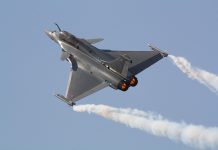
Rostec, the Russian state defense conglomerate, has rolled out a modernized variant of the Tu-95 bomber, the Tu-95MSM, which incorporates lessons derived from the ongoing conflict in Ukraine. This upgrade marks a significant advancement, enhancing the Tu-95’s ability to maintain its critical role in Russia’s military strategy for years to come.
Originally introduced in the 1950s, the Tu-95 was designed primarily to carry and deliver gravity bombs. However, from the early 1980s onward, subsequent variants were re-engineered for cruise missile deployment, solidifying their place in Russia’s long-range strike capabilities. Over the years, the Tu-95 has seen numerous upgrades, ensuring it remains relevant amid evolving threats and technological progress. The latest model, the Tu-95MSM, continues this trend, featuring new engines, avionics, and weapons systems that enhance its operational effectiveness.
One of the most notable improvements is the integration of the NK-12MPM turboprop engine, currently the world’s most powerful production engine of its type, paired with reinforced propellers. These modifications significantly enhance the aircraft’s performance, increasing its payload capacity and extending its operational range. The upgraded engine also improves fuel efficiency and provides a superior thrust-to-weight ratio, enabling the aircraft to cover longer distances without sacrificing speed or altitude—critical factors in modern warfare, where range often dictates survival.
The Tu-95MSM’s payload capacity has been expanded to accommodate a broader array of precision-guided munitions, including the Kh-101 and Kh-102 cruise missiles, which are among Russia’s longest-range weapons, capable of striking targets over 5,000 kilometers away. This extended range keeps the bomber well beyond the reach of most air defense systems. The added payload flexibility not only boosts the bomber’s strike capacity but also increases its versatility in various mission scenarios, from conventional warfare to nuclear deterrence.
The airframe has also been reinforced to support these more advanced and heavier munitions, maintaining performance despite the additional weight. Enhanced structural integrity ensures that the Tu-95MSM remains capable of carrying and deploying more powerful payloads effectively.
Avionics have undergone a comprehensive upgrade as well. The new radar, navigation, and communication systems improve the bomber’s precision and coordination during complex multi-domain operations. Enhanced sensors provide real-time battlefield data, enabling faster and more accurate targeting decisions. The inclusion of advanced electronic warfare systems improves the Tu-95MSM’s ability to defend against sophisticated enemy air defenses, enhancing its survivability in contested environments.
The Tu-95MSM’s primary weapon, the Kh-101 cruise missile, stands out for its range and accuracy. In the context of the ongoing conflict in Ukraine, the Kh-101 has proven its capability to conduct long-range strikes against high-value targets, with minimal risk to the bomber. The missile’s low-flying trajectory and advanced countermeasures make it harder for modern air defense systems to intercept, further enhancing its effectiveness. Additional reports suggest that the Kh-101 can deploy decoys to deceive enemy radar and missile defenses, making it even more challenging for adversaries to neutralize.
While the Tu-95MSM primarily employs the Kh-101, it also retains the capability to carry older, though still potent, weapons such as the Kh-22 anti-ship cruise missile. Though less precise, the Kh-22’s high speed and unpredictable flight profile make it a formidable weapon, capable of evading interception.
Looking to the future, the Tu-95MSM is expected to remain a central element of Russia’s strategic bomber fleet until at least the 2030s. However, as newer platforms such as the Tu-160M and the PAK DA stealth bomber enter service, the role of the Tu-95 will gradually decline. The Tu-160M was delivered in early 2022, and the PAK DA, which promises to be Russia’s first stealth bomber, is currently in development, with production expected to begin later in this decade.
Despite the eventual introduction of more advanced bombers, the Tu-95MSM’s legacy will endure. Its modernization—particularly in the integration of advanced weaponry, avionics, and enhanced payload capacity—has laid the groundwork for future Russian bombers. The lessons gleaned from the Tu-95MSM will undoubtedly influence the design and development of next-generation strategic bombers, ensuring Russia’s air forces remain a potent force throughout the 21st century.
The Tu-95, also known by NATO as the “Bear,” has been a cornerstone of Russian military power since the Cold War. Originally conceived for high-altitude, long-range bombing missions, the Tu-95 remains one of the most iconic bombers in service today. Although it has faced competition from more advanced bombers such as the supersonic Tu-22M3 and the stealthy Tu-160, the Tu-95 continues to serve as a reliable asset, benefiting from constant upgrades that have kept it operational and relevant.
Its enduring service is a testament to Russia’s ability to modernize its legacy platforms. Despite its age and the challenges posed by newer, faster bombers, the Tu-95’s combination of range, payload capacity, and cost-effectiveness ensures it will remain a vital part of Russia’s strategic arsenal for years to come. As newer bombers eventually replace it, the Tu-95 will continue to serve as a symbol of Russia’s long-range strike and nuclear deterrence capabilities.




